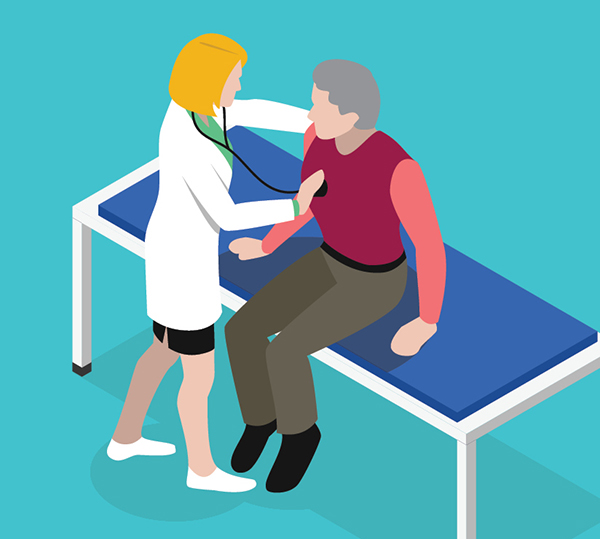IN NOVEMBER 2012, when she was 52 years old, Shannon Semple was diagnosed with a disease she didn’t have. She credits getting a second opinion with saving her life.
Semple, a physician assistant at a regional hospital in New Bern, North Carolina, had developed a persistent fever and high blood pressure. She spent a few days as a patient in the same hospital where she works, but her condition puzzled her doctors. They ultimately diagnosed her with a tick-borne illness. Antibiotics helped at first, but her symptoms returned.
“I had an overwhelming sense of unwellness,” she recalls. Later, she would learn that blood tests failed to show any signs of tick-borne diseases. In January 2013, weighed down by uncertainty, Semple returned to work at the hospital. There, she examined the CT scan of her abdomen that her doctors had ordered and spotted a large lesion on one of her vertebrae. Her radiologist had dismissed it as benign. Additional tests performed later revealed a large mass in her chest, and that led her to go to the hospital at the University of North Carolina (UNC) in Chapel Hill, about three hours away from New Bern.
The news wasn’t good, but it was accurate. Semple had metastatic cancer of the thymus, a small organ behind the sternum and between the lungs that produces a hormone to help stimulate the production of T cells—white blood cells in the body’s immune system. The thymus is only active until a person starts puberty. Then it goes quiet—most of the time. Thymic cancer is exceedingly rare; only about 400 people are diagnosed each year in the U.S. By the time Semple was diagnosed, the cancer had invaded surrounding tissue, including lymph nodes and bone. Her diagnosis in April 2013 was followed by years of difficult treatments, but if she hadn’t checked in with other doctors, she says, she wonders if she’d still be alive today.

Illustration by istock/aurielaki/mathisworks/ macrovector
Though seeking a second opinion is common, it may not be the norm among people diagnosed with cancer. Recent surveys have found that many, and probably most, cancer patients do not seek out another opinion. They may be missing out. Though few studies have rigorously examined the impact of second opinions, those that have been done suggest getting another perspective can help improve cancer care, change a treatment plan, bolster a patient’s confidence and, in some circumstances, even alter a diagnosis.
More Information, More Assurance
A cancer diagnosis brings a barrage of information about both the disease and its treatment, and it’s normal for patients to want to learn more or to wonder if another doctor would make the same recommendation. That’s where a second opinion comes in: It can help patients feel more secure in their decisions or get more information about their options.
“Patients need to have enough information and comfort with the people that are stakeholders in their clinical care,” says urologic oncologist Michael Poch at the Moffitt Cancer Center in Tampa, Florida. “Sometimes it takes additional input from another physician or another institution to be comfortable.”
Poch and his colleagues see many patients seeking second opinions and help them confirm their plan of care. “It provides some reassurance,” he says.
But not everyone seeks a second opinion. In a study published in Cancer Investigation in January 2017, for example, a team of researchers from the J.W. Goethe University in Frankfurt, Germany, surveyed 106 cancer patients and found that only about one-third had received second opinions. Of those patients who sought a second opinion, 80 percent wanted to confirm their diagnoses and roughly half said they wanted to better understand the diagnosis. The vast majority said they were reassured by the experience.
A second look may also change the direction of care. In 2005, researchers in the Netherlands analyzed data from more than 300 patients who had sought care at a second-opinion clinic in the Erasmus University Medical Center Rotterdam. Most of the patients were women with breast cancer, and all the patients had already seen an oncologist in a general or university hospital. When the physicians at the second-opinion clinic reviewed pathological and radiological charts, they recommended treatment plans different from the first opinion in more than 100 cases—or about one in three. Half of those were significant enough to trigger changes in the patient’s recommended treatment, such as advising radiation instead of surgery.
In a study led by Poch, researchers reviewed biopsy tissue from nearly 1,200 patients with bladder cancer, all of whom had been initially diagnosed at community hospitals. They reported in the July 2016 issue of Urology that the second opinion would suggest the need for treatment changes—altering a chemotherapy regimen or recommending surgery—in 15 percent of those patients. (The study did not follow up to see if treatment changes were implemented.)
Poch says he hopes his study highlights the potential benefits of second opinions, especially when a person is first diagnosed at a small hospital that may not have specialists who focus on certain types of cancer. The right diagnosis has a big impact: For bladder cancer patients, he says, it could mean the difference between having the bladder surgically removed or not, or undergoing or skipping chemotherapy.
“There’s a lot at stake” when making diagnostic and treatment decisions, agrees Mihir Parikh, an interventional pulmonologist at Beth Israel Deaconess Medical Center in Boston. “We like to think we know everything and can do everything, but a second opinion can bring an insight that I haven’t thought about, and I welcome that.”
Parikh’s job includes offering second opinions on the diagnosis and staging of lung cancer. Patients with stage I or II lung cancer can undergo surgery to have the tumor removed, but those with advanced lung cancer are often ineligible for surgery. He says confirming that a diagnosis is correct is important before proceeding to surgery or other treatments. Most of the time, he says, his evaluation backs up what another physician has already found in a patient. But this is not always the case. In 2014, when Parikh worked at the University of California, San Francisco Medical Center, a 56-year-old man came to the clinic seeking a second opinion. He had been diagnosed with early-stage lung cancer after experiencing coughs, fevers, chills and difficulty breathing. A PET-CT scan had revealed a small nodule that looked cancerous, and a surgeon had recommended major surgery to remove one of the lobes of his lungs. Parikh and his colleagues biopsied the tumor using electromagnetic navigational bronchoscopy, an approach that involves guiding tiny tools through the airways of the lung. The biopsy showed that the nodule wasn’t cancerous; it was the result of a lung infection caused by a parasite. The patient recovered following treatment with Biltricide (praziquantel), an anti-parasitic medication. No surgery was required.
The patient was surprised—and relieved. “It’s rare but awfully nice to have that situation,” says Parikh. “A good patient advocate, or a patient, or their family members will want to confirm a diagnosis before proceeding straight to surgery.”
Getting a second opinion may be especially appropriate in these situations.
- You want to be sure you have explored all options.
- You think your doctor is underestimating the seriousness of your cancer.
- Your doctor is not sure what is wrong with you.
- You have a rare or unusual cancer.
- You think another treatment might be available.
- Your doctor is not a specialist in your type of cancer.
- Your doctor tells you there is uncertainty about the type or extent of cancer you have.
- Your doctor gives you a few different treatment options.
- You’re having trouble understanding and communicating with your doctor, or you want your options explained by someone else.
- You just want peace of mind that you are making the right choice.
Source: American Cancer Society
The Right Treatment, Finally
Seeking more information can be an ongoing process during cancer treatment. After her initial thymic cancer diagnosis, Semple received chemotherapy and radiation at the UNC Lineberger Comprehensive Cancer Center in Chapel Hill. “It was pretty miserable,” she says. It was also temporary. Two months after chemotherapy, in the summer of 2013, CT scans revealed that the cancer had returned to lymph nodes in her chest. Because the cancer had spread, she was not eligible for surgery.

Illustration by iSTOCK/aurielaki/mathisworks/ macrovector
With the help of her uncle, a retired head of surgery at Memorial Sloan Kettering Cancer Center in New York City, Semple joined a clinical trial there. Starting in late 2013, she was treated with LEE011 (ribociclib), an experimental targeted drug. (The drug has been designated for priority review by the U.S. Food and Drug Administration [FDA] for the treatment of advanced breast cancer, but has not yet been approved.) For nearly a year, the drug was effective, but eventually she stopped responding to treatment, and scans showed that metastases to her bones had returned. Semple again found herself looking at her options—and for another opinion. “The first trial became the bridge to the next big thing, and that turned out to be the thing for me,” she says.
Her persistence paid off in late 2014, when she qualified for a small trial being conducted at Georgetown Lombardi Comprehensive Cancer Center in Washington, D.C., by oncologist Giuseppe Giaccone, one of only a few researchers studying thymic cancer. It was a combination of luck and good timing.
Giaccone was launching a clinical trial investigating whether Keytruda (pembrolizumab), an immunotherapy drug approved by the FDA to treat melanoma, could help patients with thymic cancer. “Most people know it as the Jimmy Carter drug,” says Semple, referring to the former U.S. president, whose advanced melanoma was treated with Keytruda. She immediately joined the trial, which began in March 2015. Keytruda works by inhibiting a protein on T cells called programmed cell death 1, or PD-1. Some tumors produce a protein called programmed death-ligand 1, or PD-L1, that binds to the PD-1 receptors on the T cells. This interaction prevents the T cells from attacking the tumor. By inhibiting PD-1, Keytruda allows the immune cells to attack cancer cells.
More than half of thymic cancers have high levels of PD-L1, which is one reason that Giaccone thought Keytruda could be effective. In Semple’s case, Keytruda worked. Three weeks into treatment, scans showed that some of Semple’s tumors were shrinking, while others had vanished. Oncologists don’t know why some patients respond better than others to immunotherapies, but for Semple, it was a good treatment. Her most recent PET scan in November 2016 showed no detectable disease.
“I’ve done a lot of studies of this tumor type and have never seen dramatic responses like this one,” says Giaccone of Keytruda’s effectiveness in treating thymic cancer patients. “I really think it’s promising.”
A Second Opinion: It’s Not Personal
It’s not easy for some patients to seek a second opinion. They may worry that it will seem like a betrayal of their doctor. “It becomes a situation of loyalty,” says Semple. But in the case of cancer, she says, it’s important to focus on getting enough information to be comfortable with the care plan. “They think, ‘I was sent here, and my doctor believes in this doctor.’ So they stick it out. But it’s not about the doctor’s feelings. It’s about these folks surviving.”
Parikh, in Boston, often fields the same questions from patients looking for another perspective. “They ask us if it’s OK to get a second opinion,” he says. “I always counsel patients not to feel sorry for asking. As a physician, I welcome second opinions. Asking for someone else’s perspective or insight or thought can only add to the betterment of patient care.”
There are many avenues to a second opinion. Some hospitals, like the Cleveland Clinic, offer an online service where a patient can get a second opinion, including a review of pathology reports. Parikh recommends that people with cancer meet with a specialist in a large cancer center—especially if they were first diagnosed in a regional hospital where an oncologist might be responsible for seeing patients with all kinds of cancer. Academic institutions or cancer centers often offer treatment insights or options, including clinical trials, that are unavailable at smaller, regional hospitals. Some health insurance plans cover all or part of the cost of getting second opinions for surgery or other major treatments; some even require them before major treatment begins. Check your plan before scheduling a second opinion. A referral from your primary care physician may be required, and you may have to consult with an in-network physician. Medicare Part B covers 80 percent of the cost of getting a second opinion before surgery and 80 percent of the cost of a third opinion if the first two disagree.
A second opinion may not change a diagnosis or even a treatment plan, but it can offer confidence moving forward. Semple thinks the most important thing is that patients get to a level where they’re comfortable with their own treatment.
“If you have this sense that something still is not right,” she says, “that’s a perfect time to get a second opinion.”
Cancer Today magazine is free to cancer patients, survivors and caregivers who live in the U.S. Subscribe here to receive four issues per year.





